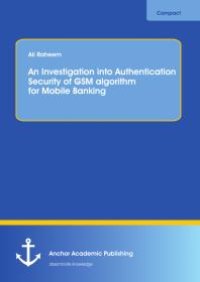
Ebook: An Investigation into Authentication Security of GSM algorithm for Mobile Banking
Author: Ali Raheem
- Tags: Cell phones., Global system for mobile communications., Mobile communication systems.
- Year: 2014
- Publisher: Diplomica Verlag
- City: GERMANY
- Edition: 1
- Language: English
- pdf
Due to the mobility of its users, GSM systems are vulnerable to an unauthorized access and eaves droppings when compared with the traditional fixed wired networks. The main idea of this project is to develop an application device in order to secure mobile banking over unsecure GSM network. It is important to mention that mobile banking is a term that is used for performing balance checks, account transactions, payments, credit applications, and many other online applications. Unfortunately, the security architecture for cellular network is not entirely secure. As a matter of fact, GSM network infrastructure is proved to be insecure. Many possible attacks are documented in literature. For security was never considered in the initial stages, the sending of protective banking information across an open mobile phone network remains insecure. Consequently, this project focuses entirely on the development and design of security techniques in order to asses some security issues within mobile banking through cellular phone network (GSM). The main aim of this project is to investigate and examine the following: 1. Security issues in each level of the mobile network architecture. 2. Messages and signals exchanged between user’s cellular phone and mobile network at each level. 3. The overall security architecture of GSM flaws. 4. Some existing security measures for mobile transactions. 5. The current security within SMS banking and GPRS banking. Finally, two folded simulations in MATLABT were performed using OFDM which is a broadband multicarrier modulation method that provides a high performance operation to transmitted and received data or information. Auszug aus dem Text Text sample: Chapter 2.2, Mobile Banking and security: Definitely, the mobile banking has become greatly important nowadays, because it is faster and easier to be used and it saves time. However, security is a big challenge to this system because hackers form the most dangerous threat to this system. They can steal data and damage the system. Such issues were discussed by different writers in an attempt to identify security problems in banking application and to suggest remedial means to these problems. To begin with, Amir Herzberg (2003) (2) has discussed some challenging issues related directly to secure payments in the banking transaction process. He provides a modular architecture which supports the security when the transactions start from the bank to the users. In addition, his architecture consisted of three important independent processes. In the first one, the device could identify the user from his card, password or from the information that was stored in the database of the system. The second process was authentication which was considered as the most important process because it could identify the user on the network of the mobile banking. Also, it supported the security in this system; the mobile authenticates the transaction request through either subscriber identification or through the cryptographic mechanism labelled as public or private key. The third process was the secure performance, which depended on the by the mobile transaction quality provided to the user. Nonetheless, these processes do not provide good secure implementation to the mobile banking transaction; therefore they cannot be taken as reliable and trustworthy. According to Chou et al (2010) (47) the mobile banking payment architecture connected up the provided operator service provides and banking institution. He went on to say that the architecture permitted mobile consumers to buy services using the SMS and WAP. Therefore this architecture just provides an alternative payment idea but does not offer a clear picture concerning the process service delivery. Elliott et al (2010) (14), however, established a payment system which used brands restrictive blinding signature to the mobile devices which could offer a multi-party security. As for Buchana et al (6), he combined the SET protocol and the TLS/WTLS protocol to enhance security services over the WAP 1.X for the payment in the m-commerce Kungisdan et al (0) on the other hand, suggested a payment protocol which provided a good measure of security. It is to be admitted here that this protocol meets the transaction security pre requisites using the public key based on payment protocols like the SET and the IKP. Laforet (2006) (27) thought that mobile Internet banking is slowly increasing in China .At that year, there was only 33 % using online banking and 14% using mobile banking. Whereas, Howecroft et, (2005) (28) reported that younger consumers used mobile banking more than older consumers. Skmm (2005) (30) considered mobile phone as a good communication tool for the users to do their banking work in short time and from anywhere and at any time.
Download the book An Investigation into Authentication Security of GSM algorithm for Mobile Banking for free or read online
Continue reading on any device:

Last viewed books
Related books
{related-news}
Comments (0)